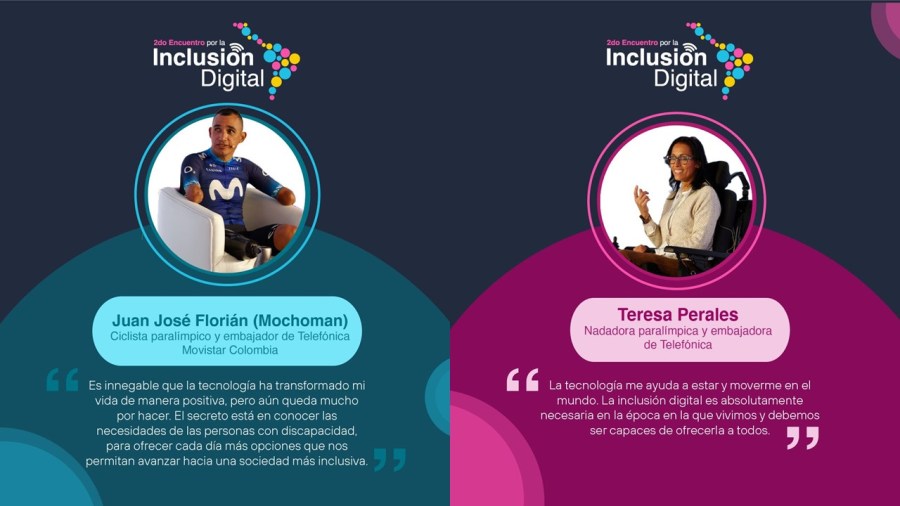Digital Inclusion in Latin America: Road to Equity and Progress
especiales

Digital inclusion is not just a desirable ideal; it is a prerequisite for sustainable and equitable development in Latin America and the Caribbean, the most unequal region in the world. Here, the richest 10% of the population has 12 times more income than the poorest 10%, and one in five inhabitants is classified as poor, according to the IDB (2024), although in some countries this proportion is considerably higher.
In this context of deep inequalities, access to connectivity and the development of digital skills have the potential to transform lives, economies and entire societies.
During the Second Meeting for Digital Inclusion, which took place on 21 October in Bogotá Colombia, experts, leaders and agents of change reflected on the possible paths towards a more connected and equitable region, highlighting the transformative power of collaboration and innovation as pillars to reduce historical gaps and build a fairer future for all people.
Connectivity as a basis for progress
In a region where more than 225 million people still lack mobile internet access, connectivity remains the first step towards digital inclusion. But progress in bridging this gap is not limited to coverage. Equally important is empowering communities to make effective use of this technology. According to the GSMA (2024), of the 225 million unconnected people, 45 million live in areas without coverage, predominantly rural, while 181 million have coverage but do not access services due to barriers such as a lack of digital skills.
Despite significant progress, such as the deployment of more than 2,500 4G sites in rural areas of Peru through the Internet para Todos (IpT) initiative, the reality is that many communities still face significant barriers to connecting to the digital world. Since its launch in 2019, IpT has brought services and connectivity to more than 3.7 million Peruvians in rural areas that previously had no coverage, and will reach more than 18,700 locations by September 2024. This initiative demonstrates the importance of addressing the connectivity gap with a comprehensive vision that not only expands coverage, but also equips communities with the skills they need to take advantage of the opportunities of the digital world.
This disconnection is not uniform. While some rural areas lack infrastructure altogether, other areas have coverage but face more complex challenges, such as lack of affordability and digital skills. As highlighted by César Martín Moreno, Ecuador’s Minister of Telecommunications, initiatives such as the free digital hotspots have shown that technology can be an effective tool for inclusion, but it is necessary to go further. Connectivity must be embedded in an ecosystem that also addresses underlying social and economic inequalities.
Mauricio Agudelo, CAF’s Director of Digital Transformation, during the Second Meeting for Digital Inclusion, reminded that closing the coverage gap is only the first step. For connectivity to be truly transformative, it is necessary to focus on the usage gaps, working on digital literacy programs and sustainable models that ensure that the most vulnerable communities can take full advantage of the opportunities offered by technology.
Digitalisation as a driver of productive development
Technology not only connects people; it also has the power to transform entire sectors and drive inclusive economic development. In sectors such as agriculture, energy and trade, digitisation can make a significant difference.
In Latin America, for example, “the water and sanitation sector uses only 1.02% of digital intermediate inputs, such as software, sensors and telecommunications services, well below the 3.11% in advanced economies. Mexico stands out with 2.27% and Chile with 1.20%, showing efficiency gains through automation and data analytics. In contrast, the agricultural sector uses only 0.30%, with examples such as 0.17% in Argentina and 0.46% in Brazil, showing important opportunities to increase productivity through digital technologies” (ECLAC, 2024).
However, structural barriers continue to limit this potential. For example, although they account for 99% of all Latin American companies, according to the OECD, and are the main source of employment in the region, the availability of their websites remains lower than that of large companies, with differences of more than 20 percentage points across the total number of companies. As Edgar Cabañas, Senior Investment Officer at IDB Invest, pointed out, overcoming this barrier will require a combination of investment in infrastructure, flexible regulatory frameworks and programmes to encourage technology adoption among small businesses.
The message was clear: the digitisation of the productive fabric must be inclusive and sustainable, ensuring that the benefits are not concentrated in a few hands, but reach the most disadvantaged communities. This will only be possible through a collaborative approach between the public and private sectors.
Digital skills: the bridge to true inclusion
Access to technology is meaningless if people do not have the necessary skills to use it. The digital skills gap is a critical barrier that affects not only employability, but also people’s ability to participate fully in the digital society.
Luis Prendes, Director General of Fundación Telefónica, emphasised the importance of non-formal educational initiatives, which are helping to close these gaps in rural areas and among vulnerable populations. These initiatives not only improve employability, but also empower communities to use technology as a tool for social change.
An example of this reflection is Conecta Empleo, a free digital training programme promoted by the Telefónica Foundation since 2016. Developed in Spain and in 8 Latin American countries, this programme aims to improve the digital skills of both unemployed people and those who wish to strengthen their training or increase their employability. With initiatives like this, the aim is not only to reduce the digital divide, but also to promote the social and economic inclusion of the most vulnerable communities, generating a positive impact in the long term.
Andreas Schleicher, Director of Education and Skills at the Organisation for Economic Co-operation and Development (OECD), presented a worrying picture during the Second Meeting for Digital Inclusion: in Latin America, only 30% of the adult population has basic digital skills, compared to 80% in developed countries. In addition, the gender gap in internet use, currently at 15%, reflects deeper inequalities that limit women’s economic participation.
Schleicher warned that “artificial intelligence will not replace people, but people with the skills to use AI will replace all those struggling with the digital transition”, stressing that the real challenge is not access to the technology, but the ability to harness its full potential. This scenario highlights the urgent need to strengthen digital skills in the region, not only to reduce existing inequalities, but also to ensure the inclusion of women and other vulnerable groups in the emerging digital economy.
Carlos Raúl Yepes, Advisor of the International University of La Rioja (UNIR), highlighted that online education can be a transformative tool, especially for populations facing geographical or employment barriers. This type of flexible and accessible education has the potential to democratise access to opportunities, bringing knowledge to those who need it most.
Inclusion as a core value
Technology has the potential to become a powerful enabler of social justice, especially in the context of digital inclusion. It is not just about connectivity, but about transforming people’s lives through equitable access to education, employment and social welfare opportunities.
Colombia’s Conectarse para Crecer (CpC) is an example of this. CpC are awards for rural women who have found a link in technology, telecommunications and digital tools to improve the quality of life of their communities, especially in rural areas, by implementing solutions that contribute to welfare and capacity building through the use of ICTs.
The awarding of the Conectarse para Crecer in the category of Rural Entrepreneurial Women took place in the framework of the Second Meeting for Digital Inclusion, on 21 October. The winners of the categories received financial support, as well as benefits in training and support in the entrepreneurial ecosystem thanks to allies such as the Universidad del Rosario, the Corporación Colombia Internacional and the Banco Agrario de Colombia.
The importance of technology is also reflected in the stories of people like Teresa Perales, Paralympic swimmer and Telefónica ambassador, who was invited to the Second Meeting for Digital Inclusion. Teresa said: “Technology helps me to be and move in the world. Digital inclusion is absolutely necessary in the times we live in and we must be able to offer it to everyone”. Her testimony highlights how technology can break down barriers and enable greater participation in society.
Likewise, Juan José Florián, Paralympic cyclist and Telefónica Movistar Colombia ambassador, who shared his perspective on the value of technology with Teresa, added: “It is undeniable that technology has changed my life for the better, but there is still much to be done. The secret is to understand the needs of people with disabilities and to provide more and more options that allow us to move towards a more inclusive society. These personal experiences show the direct impact that technology can have when it is designed and used with an inclusive approach.

These examples show that technology, when applied with a social justice perspective, can close critical gaps in education, gender equality and access to economic opportunity.
A collective commitment to the future
Digital inclusion is not only about access to the internet, but also about access to opportunities. The discussions and reflections at the Second Meeting on Digital Inclusion made it clear that we are at a crucial moment to close the gaps that still divide our region.
The path to true digital inclusion requires more than investment in infrastructure; it requires bold public policies, an evolution of the telecommunications regulatory model, and incentives for cooperation and partnerships between public and private actors. This synergy is essential to attract sustainable investment to the region and make progress in bridging the digital divide.
Only a collective effort can ensure true and transformative e-inclusion. It is time to rise to this challenge with determination. Technology has the power to transform societies, but only if we use it to connect people in meaningful ways that respect and value the diversity that defines us as a region.
Latin America’s digital future is in our hands. Let us build it together. Because when we ensure that no one is left behind, we not only advance as individuals, we grow as a more just, resilient and united society. Are you ready to be part of the change?














Add new comment